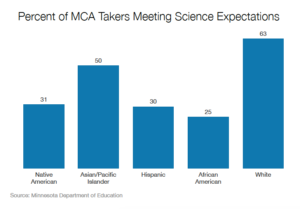Editor’s Note: Correction – This story originally reported the Minneapolis Public School District’s results as the Charter School Authorizer. The article has since been amended to reflect the actual public school district results.
St. Paul, MN- The latest report of Minnesota school test scores show wide disparities among different groups of students.
The Minnesota Department of Education’s recent release of 2016 statewide test scores shows little to no improvement for students, either as a whole or in regards to narrowing the achievement gap.
The 2016 Minnesota Comprehensive Assessment (MCA) scores released in a press release Thursday show that Minnesota students regressed in mathematics capabilities statewide. Only 61 percent of students grade 3-8 met or exceeded expectations in math, and less than half of grade 11 students did the same. This is down from 62 percent and 49 percent respectively in 2015.
60 percent of students met reading expectations on the tests, and 55 percent did the same in science. These scores are up one and two percent respectively over the prior year.
The achievement gap so many, politicians especially, are concerned about continues without an end in sight. White students are more than twice as likely as their Native American and Hispanic peers to be proficient in science, and more than two-and-a-half times as likely as their African American peers. Only 25 percent of African American students in grades five, eight, and high school met expectations in the science portion of the MCAs.

“The only way we will close these stubborn gaps is if we address with equal urgency, the opportunity gaps outside of school that impact children’s likelihood of school success,” Education Commissioner Brenda Cassellius wrote in the release, “That means paying attention to and supporting families from birth, ensuring they have access to high-quality childcare and early education, stable housing, economic opportunity, fair wages that support families and health care when they need it.”
In the Minneapolis Public School District only 44 percent of students were proficient in math, 15 points lower than statewide. Reading proficiency was slightly worse, at 43 percent, while in science proficiency statewide was 55 percent, while in Minneapolis it was about 36.
“I know we can improve our MCA scores,” Minneapolis Public Schools Superintendent Ed Graff wrote in an open letter, “But it’s more than just improving our scores on a state exam. It’s about making sure we provide our more than 36,000 students with the education and skills they need to be college and career ready.”
Things were just as bad or worse for the St. Paul Public School District, as only 39 percent of students met expectations in reading compared to 60 percent statewide. Only 37 percent of students met expectations in math, and 32 percent met the mark in science.
A large number of students opted out of the MCAs in St. Paul and Minneapolis however, leaving an incomplete picture of the educational outlook for these two districts.











